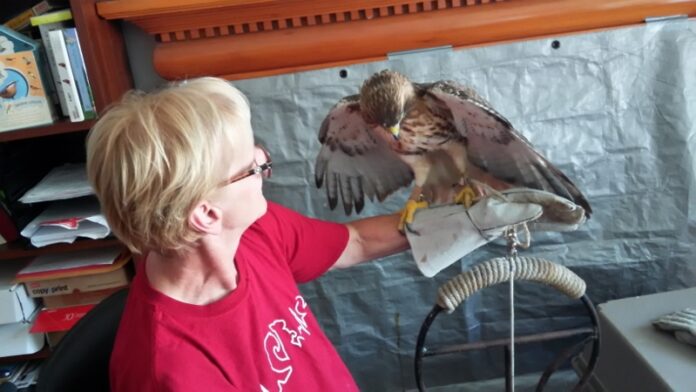
Walk into what was once a private residence at the end of Coleman Road in southwest Roanoke County – just off U.S. 221 (Bent Mountain Road) and you step into another world, one slightly wilder. Here you will find birds – lots of birds – along with possum, baby squirrels that may have come from felled trees, and even bats that have fallen out of ceilings in southeast Roanoke City.
Depending on the time of the year there may be fawns, baby raccoons or other critters inside or outside in pens.
A red tail hawk named Tuskegee that can no longer be released into the wild sits silently on a perch. He’s used as an educational aid when representatives from the nonprofit facility visit local schools and groups, talking about what the Southwest Virginia Wildlife Center, owned by Lucky and Sabrina Garvin, does: rescuing small wild animals, healing broken wings or limbs, and ushering them back into the wild when the time is right. Sabrina Garvin says they are busier than ever this year, and private financial support is always needed.

The Wildlife Center is only one of three such “Category 3” facilities in the entire state with a full time veterinarian on site, Diane D’Orazio, who was busily attending to a small bird, a bat, and then a hawk named Captain Hook. During a recent visit, she was feeding him a skinned mouse from a bag of mice. The center features a small staff, headed by Sabrina Garvin and her husband Lucky, a retired physician who also writes a column for this newspaper.
Volunteers and interns, many of whom are often college students interested in the field, provide much of the support. “We get them from Virginia Tech, Radford, Bridgewater, George Mason, Ferrum; they are allowed to stay here with free room and board but they do rotations here,” notes Garvin. “We could not exist without the volunteers and the passion they [also] have.” More local volunteers are needed (the center will help obtain the needed permits). The donation of more cages would be appreciated, as well.
The Garvins started treating small wild animals at their home in 2000 before purchasing the property at 5985 Coleman Road several years ago and renovating it. Garvin still has some of the rescued animals at home – animals often brought in after they get calls from people who find them in distress, or perhaps a homeowner or a contractor who comes across a squirrel nest in a tree they’ve just felled. Lucky was in line for a 1 AM baby squirrel feeding at their house that night; Sabrina joked that he didn’t know that just yet.
The mammal room “comes to life in March,” says Garvin during a tour of the ranch-style facility. That’s when rabbits, possums and groundhogs come in. Baby birds are the next wave and then small mammals start reappearing in mid-summer. Baby squirrels – so young there is little fur on them – need to be fed 4 to 6 times a day. Animal Control officers in the valley also bring animals to the Wildlife Center. Medicines are dispensed and weights are tracked to make sure recovery stays on course.
Possums on the mend in the mammal room will spend time outside on their path back to the wild. Why rehab a possum? “They eat about 5000 ticks a year [each],” notes Garvin, “they’re nature’s natural eradicators of ticks, which are starting to cause lots of diseases. These animals are important [to humans].”
D’Orazio has a triage room now to administer to sick animals, but a federal grant awarded to the center should mean that she will have a dedicated suite for surgery sometime early next year. Now D’Orazio has to bring animals to a local vet for surgeries and x-rays. She often consults with the Wildlife Center of Virginia in Waynesboro on medical issues, and the two facilities sometimes exchange animals in need of specific types of care.
D’Orazio treats “anything as small as a hummingbird or baby mice, on up to bobcat babies [and] eagles.” There are two fawn seasons and D’Orazio says the second one is here now. Speaking of birds of prey, the center is raising money for a 65 foot long circular outdoor “raptor cage” to be built on a concrete slab so that they can take care of big birds in a setting large enough for them to also fly around in. Price tag: $80,000.
For Garvin, what began as a passion for rehabbing animals in her own home has evolved into something much more. In addition to grants, funding from the public is crucial in order to keep the doors open. People can make donations to the non-profit through the Facebook page or via the website swvawildlifecenter.org.
“It’s something that’s needed in this area. We’re growing,” Garvin said. As of the first of August the center was 300 patients ahead of last year’s pace. “People are more concerned about the environment and the animals. We need them.”
Gene Marrano


